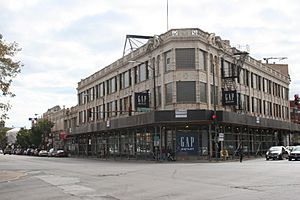Milwaukee-Diversey-Kimball District facts for kids
The Milwaukee-Diversey-Kimball District is a special area in Chicago. It is officially recognized as a City of Chicago Landmark District. This means its buildings and history are very important to the city. The district is located where the neighborhoods of Avondale and Logan Square meet. It is also seen as a gateway to the area known as the Polish Village.
This important district includes seven buildings. These buildings are all found near the busy intersection of Milwaukee Avenue, Kimball Avenue, and Diversey Parkway. The Milwaukee-Diversey-Kimball District became a Chicago Landmark on February 9, 2005.
Contents
What is a Landmark District?
A landmark district is a group of buildings or an area that has special historical or architectural value. Cities like Chicago create these districts to protect important places. This helps make sure these places are preserved for future generations. It means the buildings cannot be easily changed or torn down.
Why are Landmarks Important?
Landmarks help us remember the past. They show us how people lived and worked long ago. They also highlight special styles of building. Protecting these areas keeps history alive. It also helps people learn about their city's story.
The Polish Village Connection
The Milwaukee-Diversey-Kimball District is close to Chicago's "Polish Village." This area was once home to many Polish immigrants. They built churches, businesses, and homes here. The district's location shows its connection to this rich cultural history. It reminds us of the diverse people who helped build Chicago.
Buildings in the District
The seven buildings in this district are unique. They show different styles of architecture. These buildings tell a story about the neighborhood's past. They reflect how the area grew and changed over time. Each building adds to the district's special character.
Architecture and History
The buildings in the district often feature interesting designs. They might have detailed brickwork or unique windows. These features are part of what makes them landmarks. Studying these buildings helps us understand architecture from different eras. It also shows how neighborhoods developed in Chicago.


